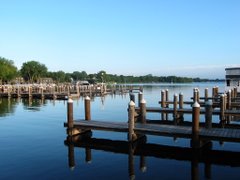Based upon late-season inspections of Grays and Phelps Bays, they are free of Eurasian watermilfoil (technically there are small amounts of milfoil, but they are operationally milfoil-free). These results are especially gratifying, as milfoil was problematic throughout the rest of the lake this season.
Recall, these two bays were treated in June to selectively kill milfoil, while protecting native plants. Representatives from several state and local agencies as well as the manufacturer of the herbicide used in this year’s treatment inspected both bays recently. The overall result – milfoil was controlled throughout the bays and there were abundant native plants.
These results are informal and the final technical results will be forthcoming later this autumn. But at this point, we are very pleased and I have received numerous calls and emails from residents of these bays who are similarly pleased. According to Mike Mason, a Phelps Bay resident, “In the 18 years that we have lived on Phelps Bay, this by far is the best that the bay has ever looked. The water is clearer, people are skiing in the open water that was once choked with milfoil, I have spent minimal time on cleaning the beach and my kids can actually swim around my dock. I also can fish off my dock without reeling in weed after weed.” According to Paul Pedersen, a long time resident of Grays Bay, “I am highly encouraged by what I see. We were told to expect the milfoil would be gone – that is what happened. I am looking forward to more seasons without milfoil.” Terry Bryce, a resident of Grays Bay since 1980, says “Marvelous! Since milfoil has been in Grays Bay, no other treatment has come close to the results this year. I can enjoy boating without milfoil clogging my prop.”
We have also been working with representatives of St. Albans and Gideon Bays, who have visited Grays or Phelps Bays and are excited about the possibility of being included in the treatment program. Indeed, lakeshore residents, businesses and the City of Greenwood have contributed to plant inventories of these two bays, which is a prerequisite step to participating in the treatment program in 2010. Other steps also need to occur, such as securing funding and permits, and these are being pursued in the next few months.
These treatments are part of a five-year demonstration project, supported by the Lake Minnetonka Association (LMA), Lake Minnetonka Conservation District (LMCD) and other agencies. The objectives of the program are to control milfoil in a safe manner throughout the respective bays, protect and improve native plants and minimize lakeshore clean up of milfoil fragments. We believe we are on track to satisfy those objectives and soon be able to offer a safe, effective and comprehensive milfoil control option for Lake Minnetonka that is sustainable and restorative.
Recently, concerns have been raised regarding the safety of the herbicides used in this program. We point out that all agencies involved in the demonstration project and program have approved the plan that prescribes their use. In addition, the LMA, LMCD, MN DNR and several cities have provided funding for this project; the MN DNR approved the plan and provided permits; and the herbicides are registered for use by the U.S. Environmental Protection Agency. Indeed, the regulatory agencies and scientists involved in the project found these herbicides were the only feasible management tool that could accomplish the project’s objectives.
The Lake Minnetonka Association is concerned with any management approach that compromises the health of Lake Minnetonka. In this case, we believe these herbicides are safe and restorative. We know that untreated, milfoil diminishes the health of the lake ecosystem by displacing native plants and diminishing plant diversity, so even not controlling milfoil has negative consequences.
Overall, we are proud of the leadership and support provided by our members – over half the financial support was provided by private, voluntary contributions. We are pleased with the results. We are grateful for the funding support provided by the Save-the-Lake Fund, a MN DNR grant, and the Cities of Minnetrista, Mound and Shorewood.
Sunday, September 6, 2009
Subscribe to:
Posts (Atom)

